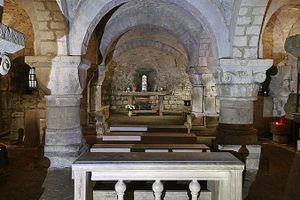
The first ecclesiastic building on this site, in Lastingham, Yorkshire, was a Saxon monastery which was written about by the Venerable Bede. The monastery was founded in 654 by St. Cedd of Lindisfarne. During the first millennium period of Viking raids in many parts of northern England, the original wood and stone buildings were destroyed.
It was not rebuilt until William the Conqueror approved the building of a church at Lastingham in 1078. The altars of the church are thought to be reworked Roman stone. The main body of the church is a magnificent building showing great examples of Romanesque architecture but it is the magnificent crypt of the church that is unique, as it is thought to be the oldest Norman crypt in the world.
It has walls that are three feet thick and is the the only church crypt in Britain with a nave, aisles and a chancel in the form of an apse at the eastern end. It is almost as if the crypt had been intended as an alternate site for services, mirroring the church above it. The crypt runs underneath the full footprint of the church above it. The crypt was built initially to house the bones of St. Cedd, but at least some of these were later moved by his brother, St. Chad, to Lichfield.
The crypt is supported on four stone pillars thought to predate the Norman Conquest, and has not been altered since the time of William the Conqueror. It can be accessed by a staircase descending from nave. It is reported that during the 18th century, the barbaric sport of cock-fighting took place in the crypt—whether the clergy and/or churchwarden knew about this usage is unclear.
Within the crypt today is an original ancient burial bier and also the remains of an ancient carved stone cross, previously 24 feet high, which was replaced, in the 19th century by the current (12 foot high) cross at the top of Rosedale Chimney Bank, about four miles away, known as Ana Cross. Like the current cross still does, the impressive old Ana Cross stood atop a Bronze Age burial mound on the open moor.
In the body of the church are numerous memorial tablets and inscriptions of which a notable one is to Sidney Ringer, a physician whose research led to the adoption of saline solutions for use as blood replacement (and as a diluent in microbiological and physiological research). Dr Ringer is buried in the church yard.

